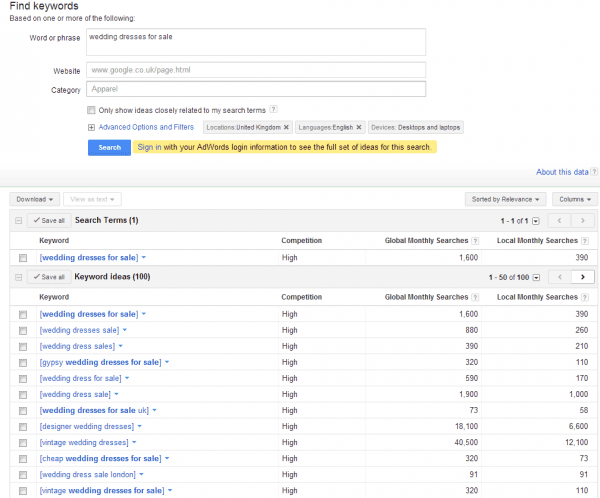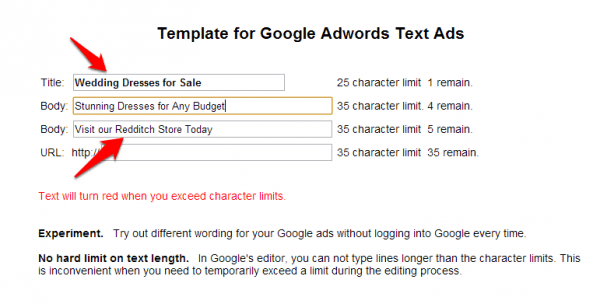A 6 Step approach for Targeting Local PPC Campaigns
Last month, I shared my tips for carrying out a local SEO audit on your website. But that’s only half the story.
It’s not just your organic SEO that needs to be geo-targeted. With Google placing a great visual emphasis and authority on PPC adverts, you should be integrating geo-targeted ads in your marketing mix. A geo-targeted PPC campaign works best for businesses who perform their services locally, but could attract customers from further afield.
Let's take a UK example, Mrs Jones runs Blue Widget Weddings, a store selling wedding dresses in Redditch, UK.
She obviously wants to attract brides from her local area – Redditch, Bromsgrove, Birmingham and Droitwich. This makes Mrs Jones the perfect candidate for a local PPC campaign.
Six step Paid Search campaign plan for a local business
Here, is a six step plan she, or any other local business, can follow to create a robust paid search campaign to promote their local business:
Using the Google AdWords Keyword Planner – the Keyword Tool is soon to be no more, so get used to the new interface, create a long list of keywords based around your business.
The sky really is the limit here, so don’t be concerned if your list hits the hundreds. Aim for a combination of general terms and those with a regional qualifier. For instance; Mrs Jones’ list would include ‘wedding dresses for sale’ and ‘wedding dresses for sale Redditch’.

This tool will show you both the local and global monthly searches for your chosen keywords, as well as the average cost-per-click (CPC). This will help you identify a suitable budget to help you achieve your goals.
At this stage, you should also identify your negative keywords; these are the words you want to exclude from your campaign. For instance; Mrs Jones may wish to set ‘second hand’ as a negative keyword.
The second step involves creating two separate campaigns; one locally targeted and one national campaign.
In your local campaign, create ad groups for all your geo targeted keywords; including all your generic terms in the national one. This will help you create a set of targeted ad groups, as well as keeping your individual adverts organised.
There’s a limit of 20,000 ad groups you can create; but a top tip is to keep all your related keywords in one group. Mrs Jones would have ‘wedding dress shop Redditch’ and ‘wedding dress shop in Redditch’ in one ad group for instance.
Once you’ve created your campaigns and ad groups, it’s time to craft your ad copy.
You need to include your town name in your geo campaigns, and your general keyword in all local campaigns. The catch is though, that you only have 25 characters to use in the title and 35 on each line of your body copy.
This doesn’t give you an awful lot of space to grab your customers’ attention; crafting copy for PPC ads is often an art form in itself. To help you keep your ads to the right limit, you should use this ad design tool.

You should create at least 2 adverts for each ad group you have so you can test them against one another. This stage comes later, but get yourself prepared now.
Your PPC adverts are only half the story though. It’s one thing to encourage someone to click through onto your advert; but another to make them perform the desired action on your website.
In order to boost your conversion rate, it is essential that you carefully choose the perfect landing page for your advert. In the case of Mrs Jones and her local wedding boutique, she should direct people to a geo-specific landing page. This can be a page that already exists on the site, or a specific PPC landing page.
Either way, you need to make sure your adverts and landing page work in perfect harmony to sell your products and services.
Like your other marketing methods, you need to be monitoring your Google AdWords adverts.
Your first step is to add AdWords Conversion Tracking, and make sure that all your PPC campaigns are linked to your analytics software. This will help you see how each advert is performing; which is generating the most clicks, which is resulting in the most conversions, and which aren’t performing as well as expected.
This then leads on to our sixth and final step.
Finally, you need to be constantly testing and tweaking your adverts. Once you have an idea of how they are performing, you can make the necessary changes to get maximum ROI.
Remember those adverts you created for testing? Here is where you analyse the results, and see what kind of tone and message appeals most to your audience. Try and appeal to different emotions with your adverts, to see which resonates best with your target market. This stage is on-going throughout any PPC campaign, so be sure to keep testing and tweaking.
For more tips on getting the most out of PPC marketing, check out The Savvy Marketers Guide.
Setting up a local PPC campaign is a great way to send targeted traffic to your website. And the best thing about this kind of traffic? You already know that you have the kind of product your audience is looking for.

Thanks to Clare Evans for sharing her advice and opinions in this post. Clare is an online SEO Copywriter for UK digital marketing agency
Superdream. You can connect with her on
Google+. For more in-depth tips and advice, download our
Local SEO Whitepaper.





 Thanks to Clare Evans for sharing her advice and opinions in this post. Clare is an online SEO Copywriter for UK digital marketing agency
Thanks to Clare Evans for sharing her advice and opinions in this post. Clare is an online SEO Copywriter for UK digital marketing agency 


